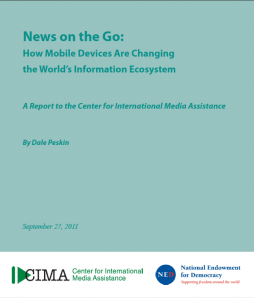information
Posted by MelissaUlbricht on Sep 30, 2011
A new report from the Center for International Media Assistance (CIMA) at the National Endowment for Democracy “examines questions about how a global information society might look with mobile media devices at its hub.” The report, News on the Go: How Mobile Devices Are Changing the World's Information Ecosystem, is available for download here.
According to the report, at the end of 2010, more than 4 billion people paid for mobile serivce. By the end of this year, about 5 billion mobile phones will be in service in a world with 7 billion people. The report suggests that the implications of so many people having access to phones are many: for politics, for education, for economies, for civil society, and for news and information.
While it offers several examples of mobile case studies in these various issue areas, the report focuses primarily on the growth of mobile Internet, and, hence, high-end smart phones over basic feature phones.
At MobileActive.org and on the Mobile Media Toolkit, we write often about the role of and potential for the basic feature phone. The CIMA report takes the stance that while 5 billion people will have access to mobile phones, by the end of this year “virtually every phone sold” will be a more high-end device.
Posted by ToniTwiss on Aug 30, 2009
Ubiquitous Information - Mobile Phones in the Classroom data sheet 2876 Views
Abstract:
A New Zealand Ministry of Education eFellowship report on the use of mobile phones in classrooms to foster information literacy skills.
The report considers the impact ‘anytime’ access to information via access to the mobile internet will have on teaching and learning in the future. It explores the potential applications for mobile phones in the classroom and the skills that students will need in order to cope with the mass of information on-demand that is available to them.
The research conducted for the purpose of this report involved a class set of 30 3G mobile phones being made available for a single unit of work by three different classes; a Year 12 Media Studies, Year 9 Social Studies and a general Year 8 class. Each unit of work ran for approximately 5-7 weeks. The teachers involved in the study were given support to learn how to use various functions of the mobile phones and to plan their unit of work.
The findings of this report indicate the following:
- Applications and tools available for use via a mobile phone, including access to the world wide web, have a great deal of potential for use in schools.
- Currently cost of data is the single biggest factor in limiting this use.
- While as teachers we are constantly being told our students are ‘digital natives’, many of our students are not as au fait with technology as teachers are led to believe. Students are being labelled the ‘net-gen’ and teachers who have been told that they are ‘digital immigrants’ often do not see that the skills they believe their students to have are not always present. While students may seem very ‘tech savvy’ they still need to be taught the skills to deal with the world that their use of technology gives them access to, namely the world wide web and information overload.
- Key factors identified by secondary school teachers as impacting their ability to teach information literacy included limited access to resources (particularly technologies for accessing the world wide web), access to professional development and the impact of timetabling leading to a highly segmented curriculum.
Posted by neilp on Aug 11, 2009
Avaaj Otalo data sheet 4308 Views
Organization that developed the Tool:
Problem or Need:
Agricultural information access for small-scale farmers in rural India.
Brief Description:
Avaaj Otalo ("voice-based community forum") is a system for farmers to access relevant and timely agricultural information over the phone. The system was designed in the summer of 2008 as a collaboration between IBM India Research Laboratory and Development Support Center (DSC), an NGO in Gujarat, India.
By dialing a phone number and navigating through simple audio prompts, farmers can record questions, review and respond to others, or access content published by agricultural experts and institutions. In addition to the Q&A forum, Avaaj Otalo includes an announcements board of headline-like snippets updated regularly by DSC staff, and a radio archive to listen to past episodes of DSC's popular weekly radio program.
Key Features :
IVR system for information access and sharing of experiences amongst small-scale farmers in rural India.
Main Services:
Interactive Voice Response (IVR)
Organizations Using the Tool:
Development Support Center
Handsets/devices supported:
Reviews/Evaluations:
Publications:
http://www.stanford.edu/~neilp/pubs/chi2009_patel.pdf
http://www.stanford.edu/~neilp/pubs/slt2008.pdf
Is the Tool's Code Available?:
